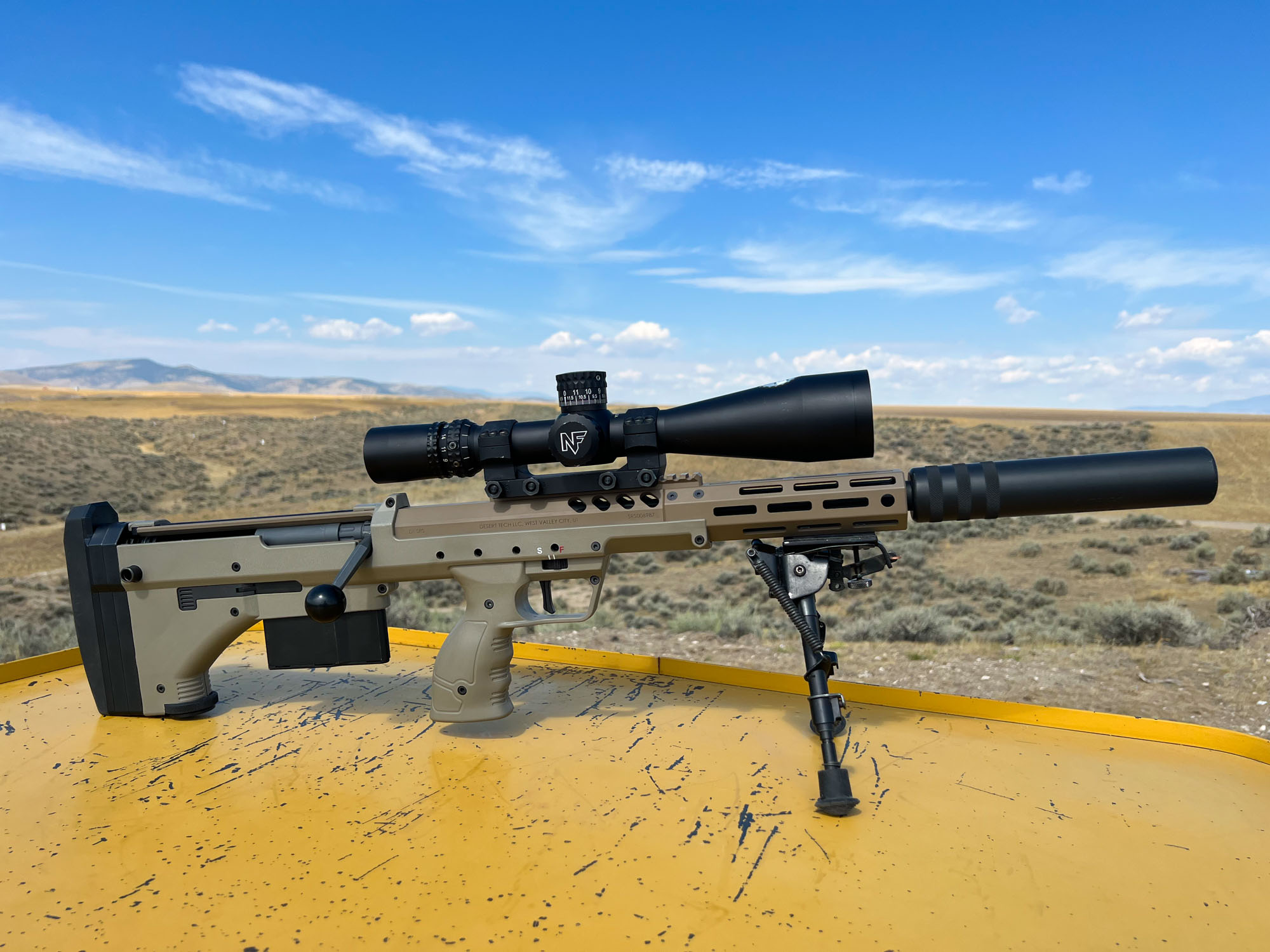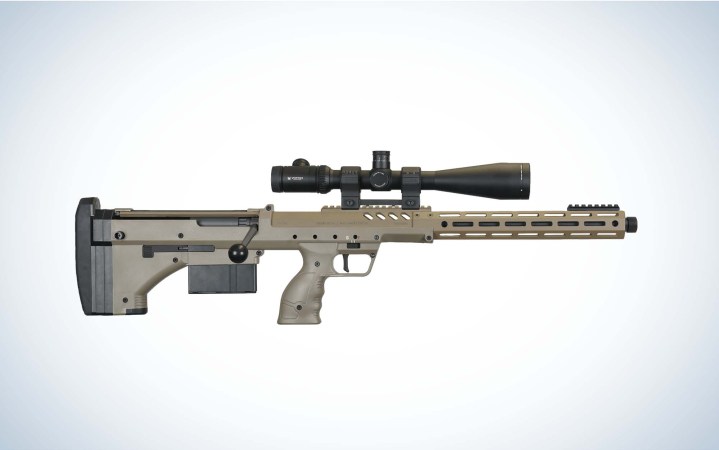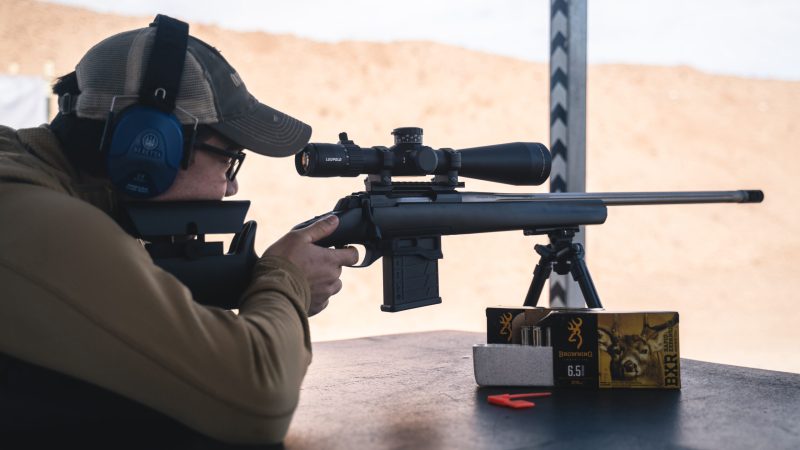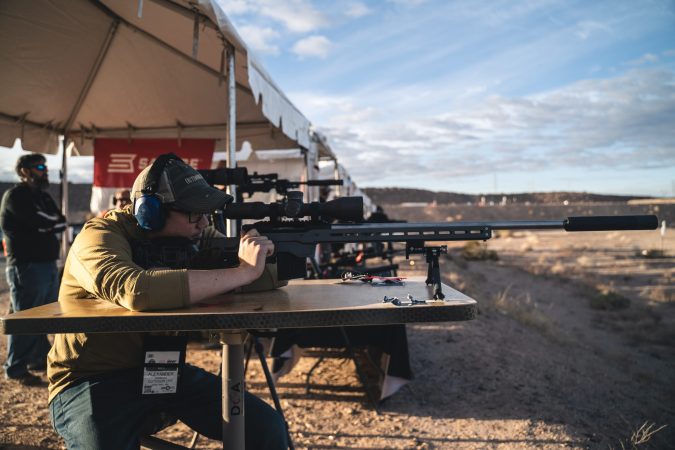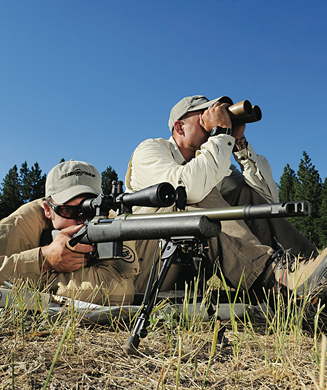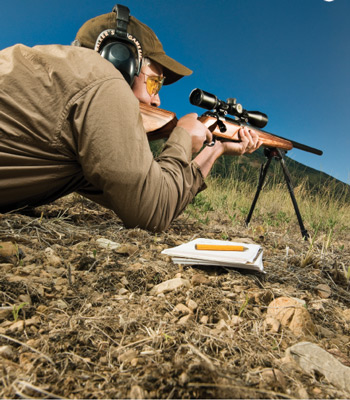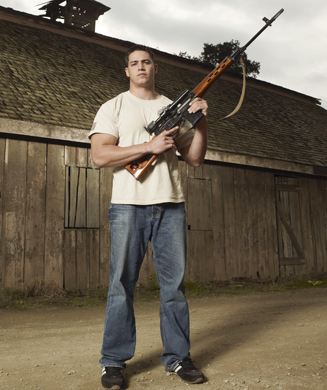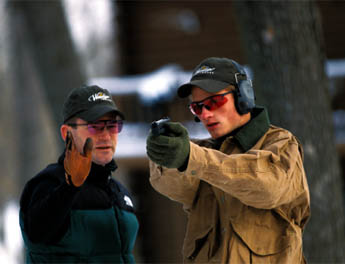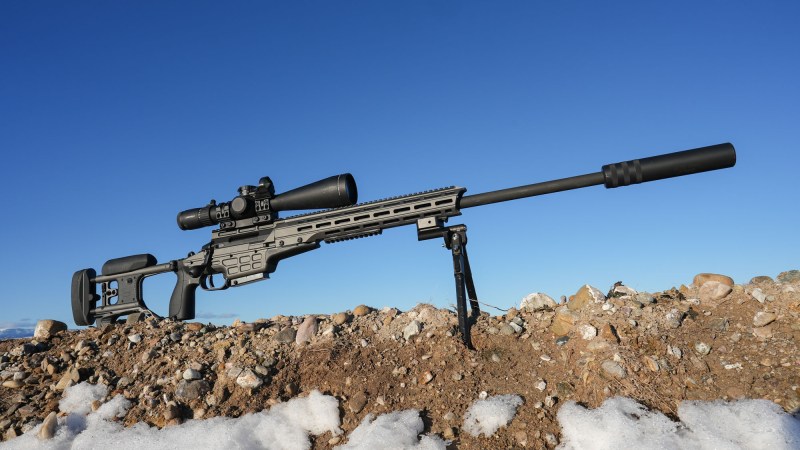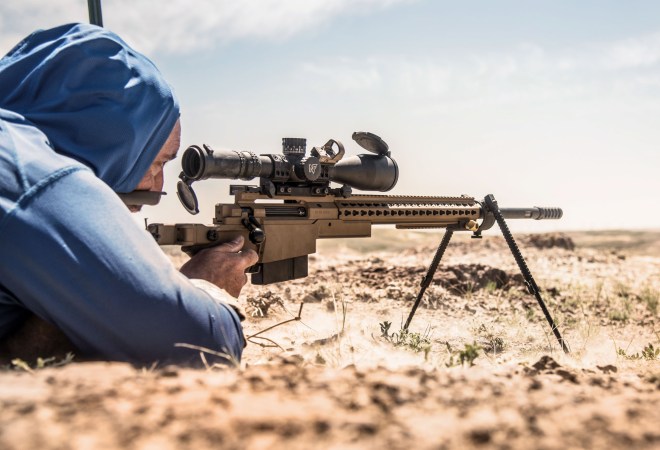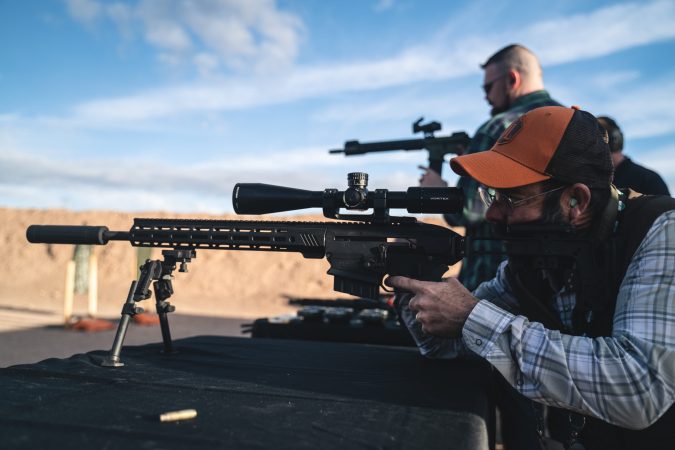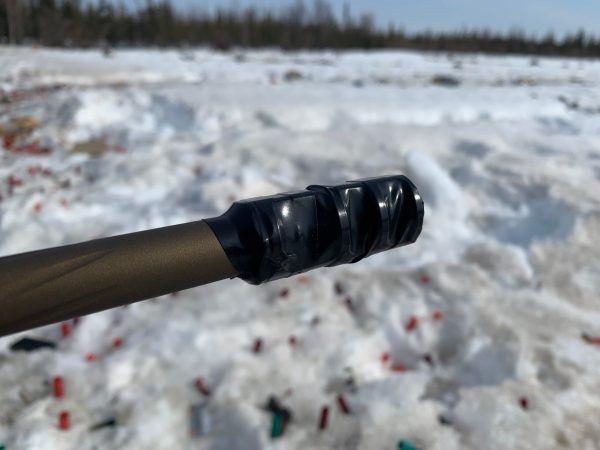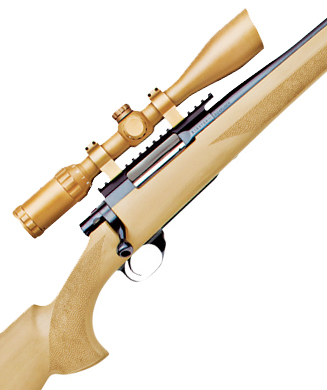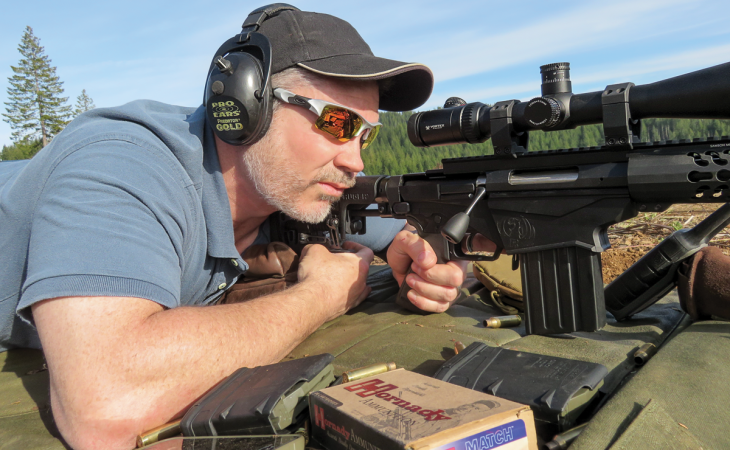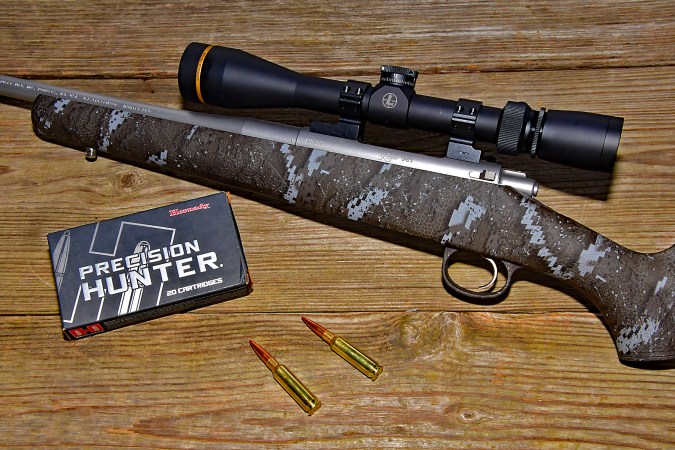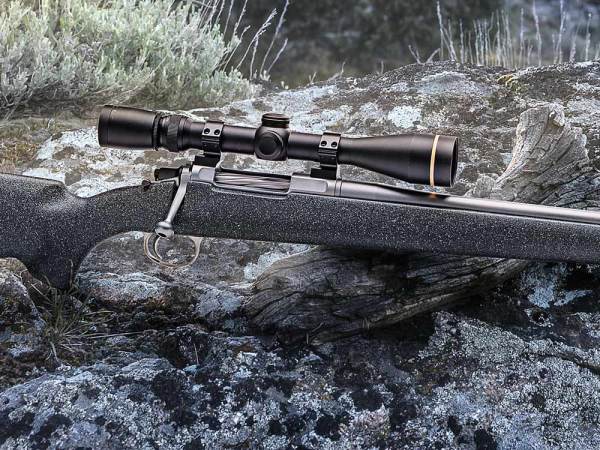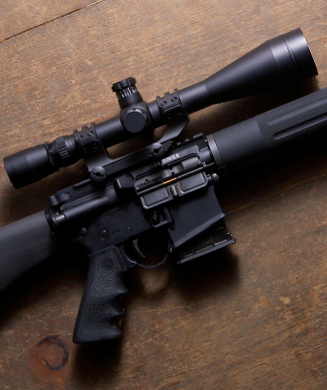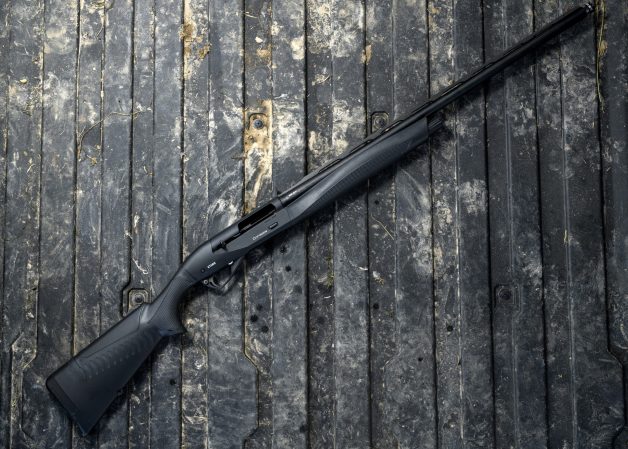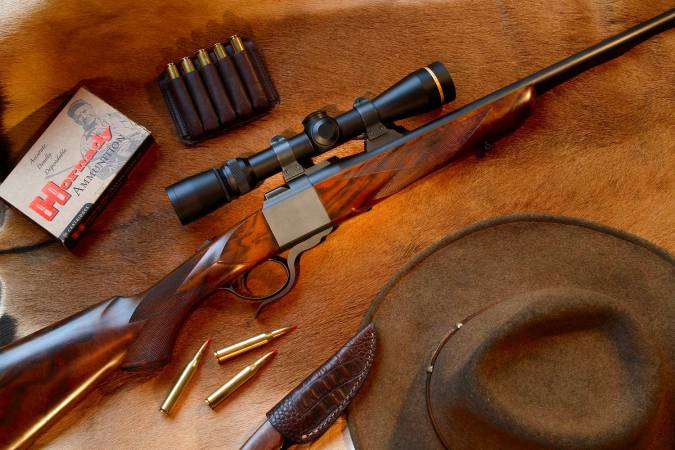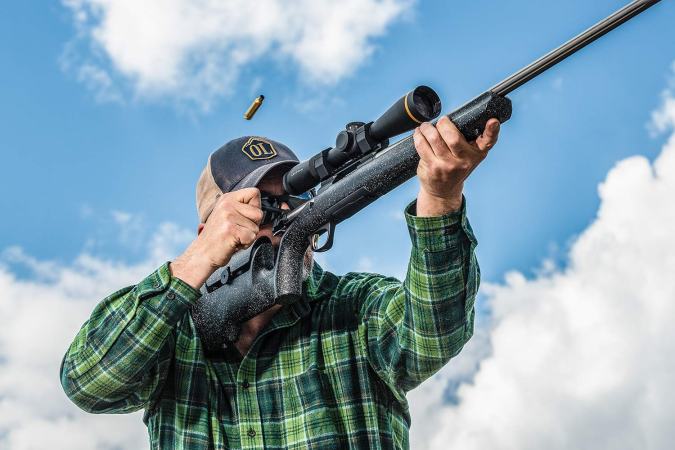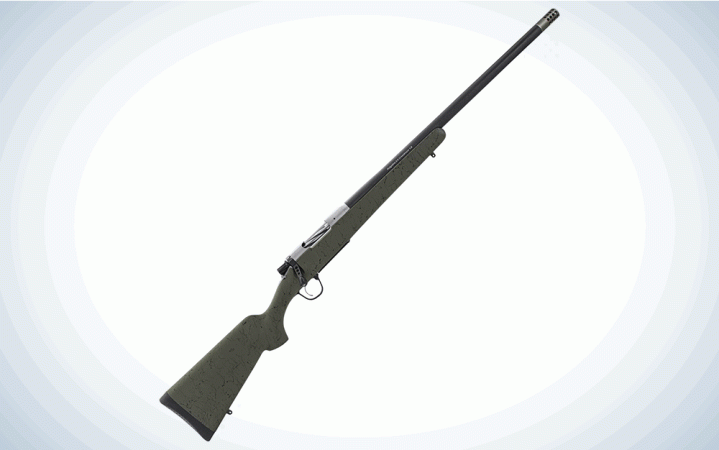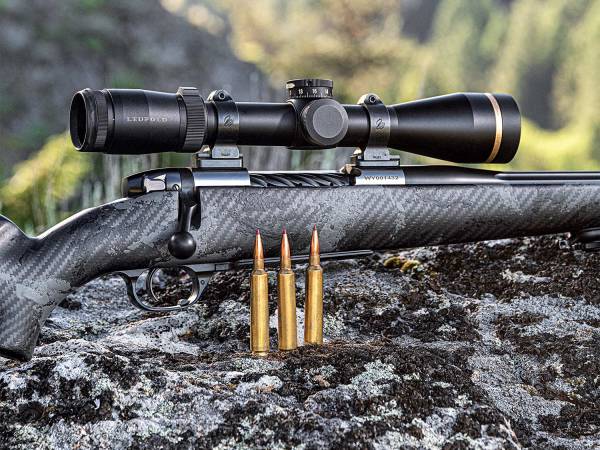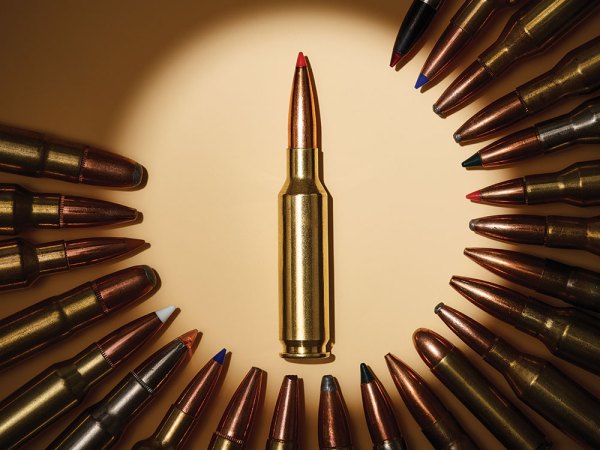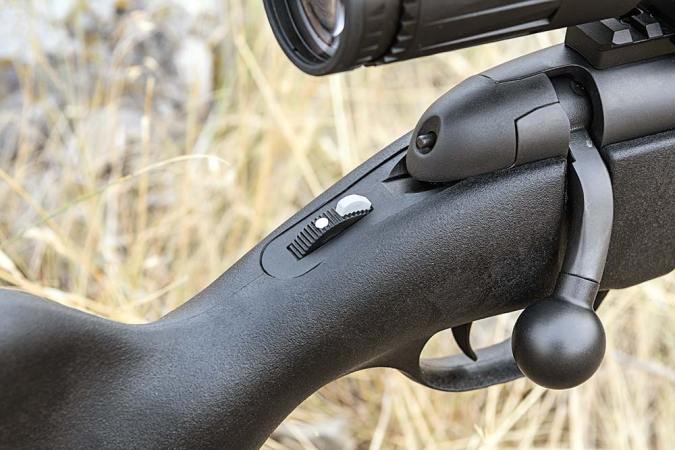We may earn revenue from the products available on this page and participate in affiliate programs. Learn More ›
The Desert Tech SRS is a true multi-purpose precision rifle. It is a switch-barrel bullpup system that lets the user swap configurations based on their needs. For people who carry such rifles for work, the Desert Tech SRS can be outfitted to minimize its visual and auditory signature by running it with shorter barrels that are optimized for subsonic munitions, or it can be equipped to take longer shots with barrels and cartridges for that task.
For recreational shooters who are intrigued by the Desert Tech SRS’s modular design and futuristic looks, the rifle is a fun and capable platform that can be expanded upon as the shooter’s desire, and budget, allows. With the base rifle in hand, a shooter can add barrels and hardware for various pursuits, including long-range shooting, big-game hunting, predator control and general plinking.
Desert Tech SRS A2 Specs
- Stock: Chassis with integral monopod, adjustable LOP and comb height
- Cartridge: 6.5 Creedmoor and .308 Win.
- Magazine: Single-stack six-round
- Action: Six-lug (Two rows of three)
- Ejector: Single plunger
- Extractor: Modified Sako
- Trigger: 2 lb. 10 oz. (measured)
- Overall Length: 34.25 in. (6.5 CM); 28.25 in. (.308 Win.)
- Weight: 9 lb. 6 oz. (6.5 CM); 8 lb. 7 oz. (.308 Win.)
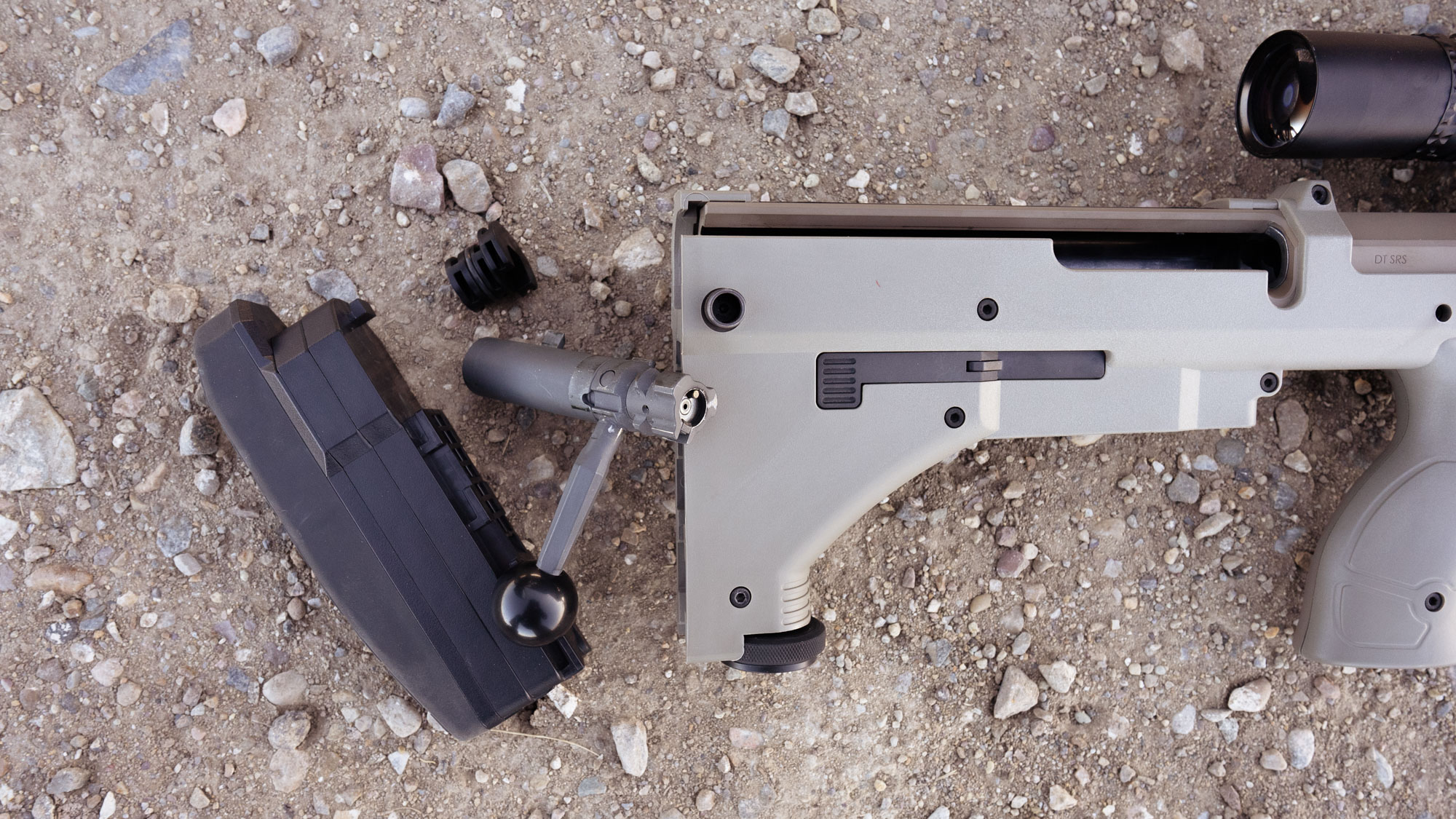
Desert Tech SRS Conversion Kits
My Desert Tech SRS came with two barrels, one a 16-inch .308 Win. with a 1:8 twist for use with subsonic ammunition and the other a 24-inch 6.5 Creedmoor. Both barrels had an appropriate length handguard. While the stubby 7-inch guard that came with the .308 barrel could be used with the longer 6.5 Creedmoor system, the reverse was not true.
When you get an extra barrel from Desert Tech, you don’t just get the barrel, which is why the company refers to them as conversion kits. In addition to the stainless-steel barrel, you get a bolt assembly, bolt stop and a magazine. While I could use the same bolt assembly, bolt stop and magazine for the 6.5 Creedmoor and .308 Win., since they are both short-action cartridges that use the same bolt face, if I were to add one of the magnum calibers to my rifle, I’d need to swap out all the pieces.
The standard calibers come with 6-round magazines, while the magnum cartridges use 5-round magazines. Some of the magnum conversion kits include either a two- or three-port Aftershock muzzle brake as well.
Here are the kits, and prices currently listed on Desert Tech’s website. To find them all you need to do a little digging under each of the three SRS models: The A2, the Covert, and the M2.
- 6.5 Creedmoor, 18-inch barrel, 1:8 twist ($1,700)
- 6.5 Creedmoor, 24-inch barrel ultralight ($1,700)
- 6.5 Creedmoor, 26-inch barrel ultralight ($1,900)
- 7mm Rem. Mag., 26-inch barrel ultralight ($1,900)
- .308 Win., 16-inch barrel, 1:8 twist ($1,700)
- .308 Win., 26-inch barrel ($1,700)
- .308 Win., 22-inch barrel ($1,700)
- .300 Norma Mag., 26-inch barrel ($1,900)
- .300 Rem. Ultra Mag., 26-inch barrel ultralight ($1,900)
- .300 Win. Mag., 18-inch barrel, 1:8 twist ($1,900)
- .300 Win. Mag., 26-inch barrel ultralight ($1,900)
- .300 Win. Mag., 26-inch barrel ($1,900)
- .338 Lapua Mag., 26-inch barrel ($2,050)
- .338 Norma Mag., 26-inch barrel ($2,050)
Compact Precision
In a bullpup design the rifle’s magazine is positioned behind the trigger guard, underneath the buttstock. This moves the action and barrel several inches rearward, significantly reducing the overall length of the rifle. Even with the 24-inch 6.5 Creedmoor barrel on board, the rifle is just 34.25 inches in length. When I swapped that out and ran the 18-inch .308 barrel, the overall length of the rifle dropped to 28.25 inches.
This makes the rifle handy to maneuver in compact spaces. It’s easy to understand the appeal of the Desert Tech SRS A2 for military and law enforcement in urban environments, and for those who must get in and out of vehicles frequently, or who are attempting to create stable shooting positions in cramped quarters.
The bullpup’s cut-down dimensions don’t hinder the rifle’s precision in any way. Desert Tech backs the SRS with a half-MOA guarantee when running match ammo.
What that accuracy guarantee means in practical terms is up for debate. Are those three- or five-shot groups? Are they saying that it will shoot that tight each and every time? Or will it do it with seven groups out of 10 consistently? But without getting wrapped around the axle with those specifics, the bigger point is that the Desert Tech SRS A2 promises to be a shooter.
How The Desert Tech SRS A2 Shot
With the 6.5 Creedmoor barrel, the SRS A2 shot consistently well. As always seems to be the case, some loads outperformed others. The one that really stood out was Sig Sauer’s 130-grain Elite Hunter. Five shot groups from this ammunition averaged .657 inches.
Other 6.5 Creed loads were consistently sub-MOA with five shot groups, too. Since this is a precision rifle, I spent more time ringing steel on long-range targets than punching paper at 100 yards. On 1- to 2-MOA steel the rifle had no issue making hits out to 1,100 yards. The targets 800 yards and in were like clockwork once I got attuned to the wind.
None of this surprised me in the least with the 6.5 Creedmoor. I was more curious to see how the .308 Win. barrel, with its fast 1:8 twist, would fare.
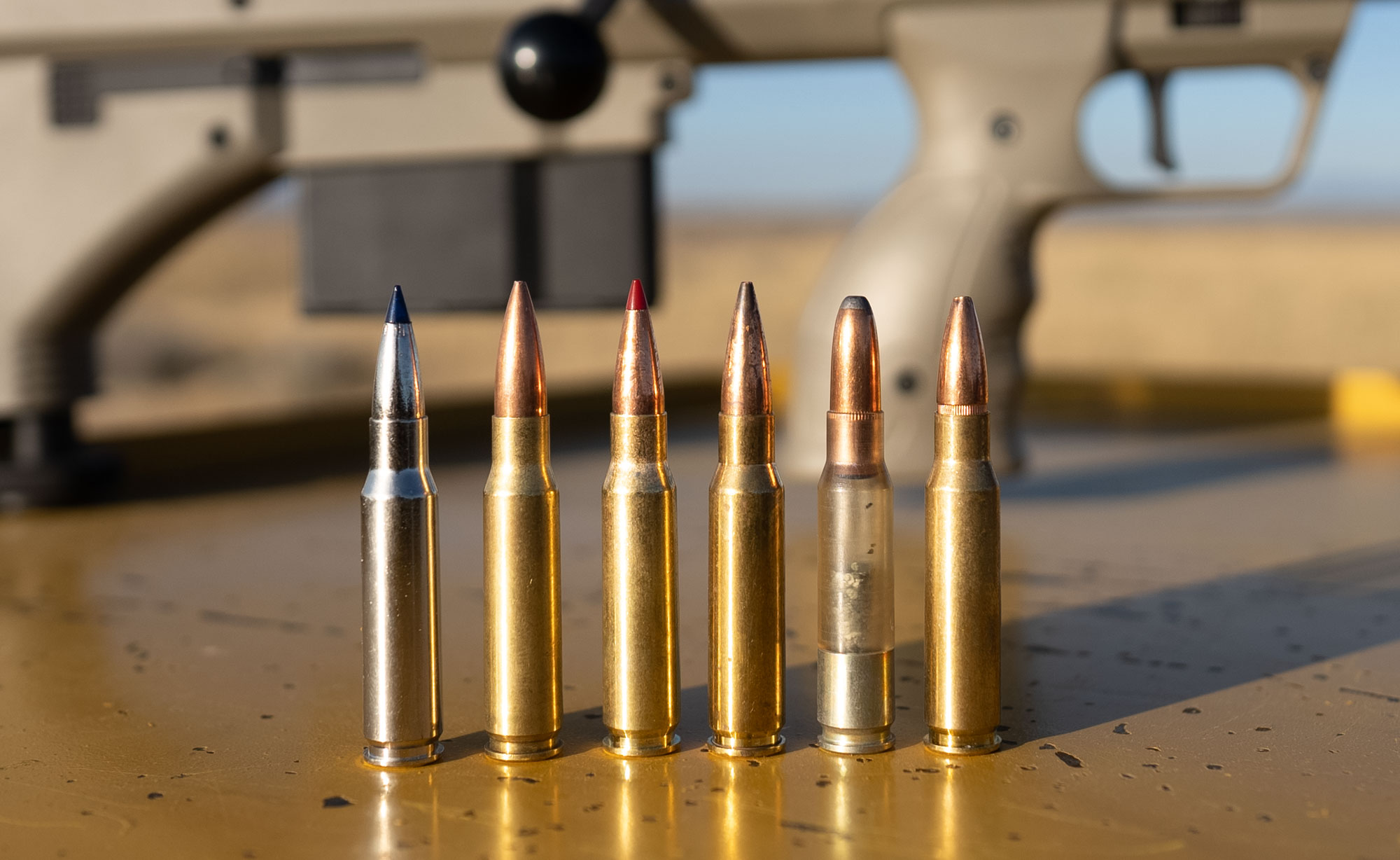
Testing With .308 Win.
I ran six different .308 loads through the rifle, including two subsonic loads. The fast twist rate on the barrel is meant to help stabilize heavy subsonic rounds, which don’t usually shoot well from standard twist (1:10) .30-caliber barrels.
The results of my shooting were interesting. The short .308 barrel was one of the more finicky barrels I’ve ever evaluated, with a couple loads doing extremely well, while others struggled to group.
First, let me be clear that I don’t fault rifle or barrel for this performance. A 16-inch, fast-twist .308 is already a bit of an odd duck, and subsonic centerfire ammo is not known for its ability to group consistently. And with a .308 barrel with a more standard length and twist rate, I’m sure some of the other loads would have done better as well.
Subsonic .308 Win. Loads
Of the two subsonic loads, Winchester’s 168-grain OTM did the best. Of the three 5-shot groups I put on paper, two of them seemed to stabilize well. They measured 1.435 and 1.775 inches. A third group opened to 3.282 inches and the bullet holes in the paper were slightly oblong, indicating a fair amount of yaw in the projectiles.
The other sub-sonic ammunition was a 220-grain load with a polymer case that is no longer produced. Those didn’t group well at all. The five-shot groups ranged in size from 2.5 to 2.9 inches with all the shots creating asymmetrical holes in the paper, again indicating issues with projectile stability.
The barrels on the Desert Tech SRS A2 come threaded 5/8-24 in the .30-caliber chamberings and smaller. With an Elite Iron STFU attached noise signature from the sub-sonic loads was negligible. If you were doing night-time close range predator control or hog hunting, the Winchester 168s wouldn’t be a bad choice.
Standard Velocity .308 Win. Ammunition
With the standard supersonic loads I tested there was also a fair bit of variance in the performance. The two highlights were Federal’s 175-grain Sierra Matchking, which has been one of the best and most consistent factory .308 loads for a long time, and Federal’s 175-grain Terminal Ascent. The Terminal Ascent is a new long-range hunting bullet that’s been developing a good reputation for accuracy and terminal performance.
My average group size with the Terminal Ascent was .643 inches, with the best group measuring .578 inches. The Sierra Matchking’s best group was .707 inches, with an average group size of 1.059 inches.
Interestingly, the other 175-grain load I tested in the rifle—Barnes 175-grain OTM—didn’t cover itself in glory, turning in groups that averaged 2.145 inches. I got another surprise with Hornady’s 178-grain ELD-X ammunition. Normally, the ELD-X bullet in Hornady’s Precision Hunter line shoots extremely well, but in this rifle the groups averaged 2.135 inches, and the target indicated some issues with bullet stability as well.
This just goes to show you how important it can be to shoot a wide variety of brands and bullet styles when trying to get the best from a rifle.
Desert Tech SRS A2 Ergonomics
The designers of the SRS A2 did a great job with the rifle’s ergonomics. With a bullpup, the buttstock needs to accommodate the magazine, the cycling of the bolt, and it is where the rounds are fed into the action. This puts some serious constraints on the ability of the stock to adjust to fit the shooter. Despite this, Desert Tech managed to create a stock where the length of pull (LOP) and comb height can be easily altered to the shooter’s preference.
Stock Adjustments
The cheek piece on the rifle is held in place by two fasteners, and when loosened they allow for .37 inch of vertical travel. That doesn’t sound like much, but it was plenty for me to get my head aligned behind my scope, which had a 56mm objective lens.
The LOP is even easier to adjust. My rifle came with two ½-inch spacers that clip in between the recoil pad and the stock. These polymer shims can be added or removed quickly without tools. Taking the recoil pad and spacer assembly off the stock is also how you remove the bolt and bolt stop from the rifle for maintenance and when swapping calibers.
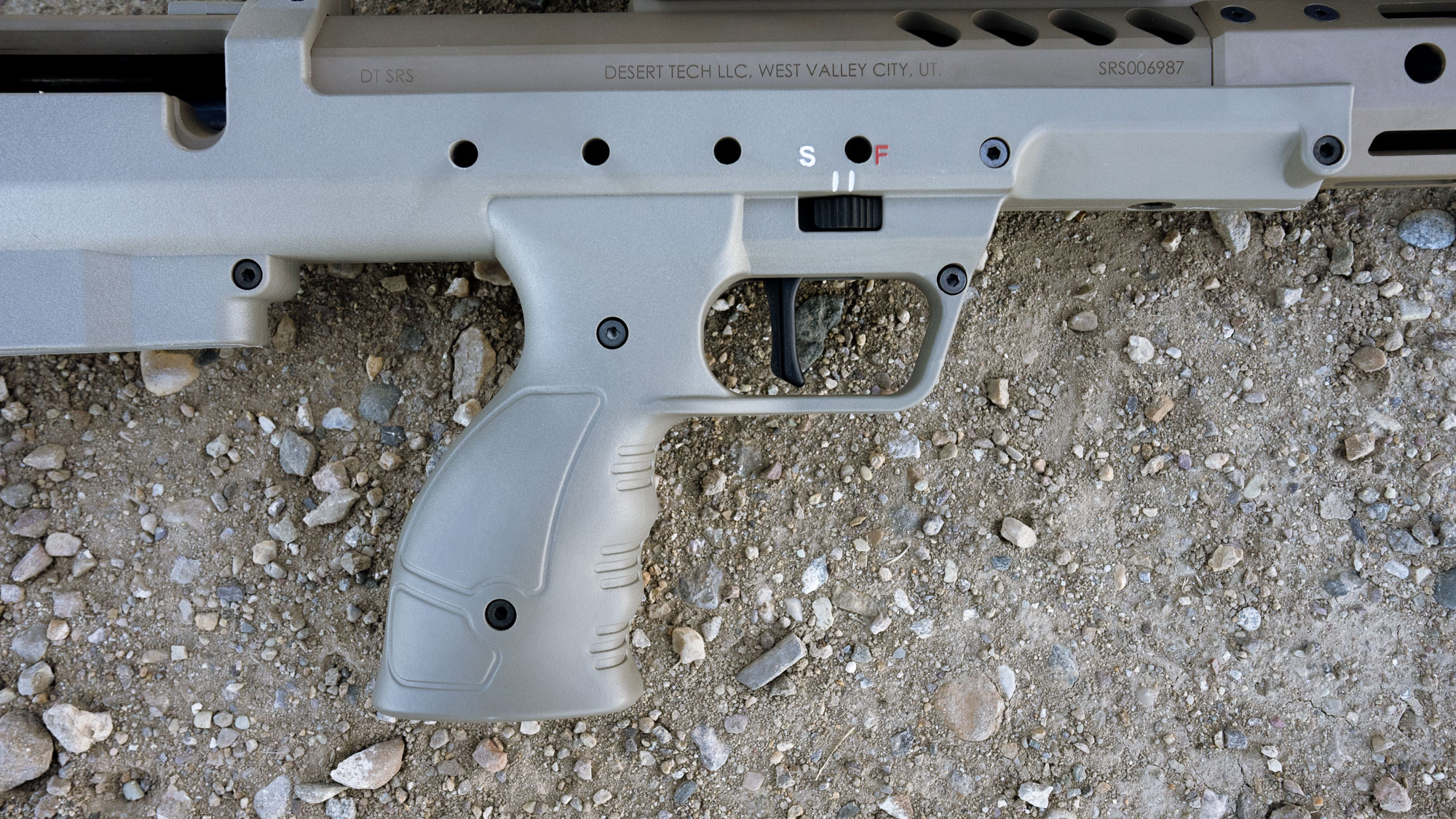
Grip Profile and Trigger
The pistol grip is thin at the top and sweeps back creating a hand-filling profile. It is cleverly shaped so that the trigger finger can easily reach the trigger while the bulk of the grip supports the lower portion of the shooting hand.
The trigger has a vertical shoe allowing the trigger finger to rest flat against its surface and press in a straight line backward for excellent trigger control. The trigger on my sample broke at 2 pounds 10 ounces with a small amount of takeup that made it almost feel like a two-stage trigger. The break is exceptionally crisp, which is often a drawback of bullpup rifles as the trigger is usually connected to the sear by a long transfer bar that degrades the quality of the trigger pull.
Safety and Monopod
The rifle comes with a simple two-position safety positioned just above the trigger. It is ambidextrous and toggles forward to fire and slides back to go on “safe” and can be manipulated from either side of the rifle. When in the safe position the trigger is blocked and unable to move to the rear.
One very cool feature on the Desert Tech SRS A2 is the integral monopod in the stock. It has a round base with texturing around the rim, and when rotated it extends below the stock to form a rear support. It deploys fairly quickly and has about 3.25 inches of travel.
Running the Desert Tech SRS A2
To prevent the rifle from becoming awkward to run, the bolt handle is attached at the front of the bolt body, just behind the bolt head. The bolt knob is still a bit farther back on the rifle than you’ll experience with a regular bolt gun—by about four inches or so—but the oversized knob and longer bolt arm give you plenty of leverage to cycle the action.
The action on the rifle runs fairly smoothly and the rifle feeds very reliably. The single-stack magazine is easy to load and I never experienced any type of failure with the feeding of rounds into the chamber from the magazine.
Single rounds tossed into the chamber when I had run the rifle dry chambered well most of the time, though on occasion some cartridges hung up in the action, which isn’t uncommon.
While I never had a failure to eject, the brass doesn’t kick free of the rifle with any type of authority. The empties sort of flopped out in an indifferent manner.
The stock has magazine release buttons on either side for ambidextrous operation. Even though the space under the stock is cramped when shooting prone, I was able to maneuver magazines in and out of the rifle fluidly.
While the rifle is compact, it is still fairly beefy. Unscoped and with the magazine out, the 6.5 Creedmoor’s base weight is 9 pounds 6 ounces. With the short-barreled .308 Win. that drops to 8 pounds 7 ounces. But with the scope—and granted I was running a hefty Nightforce 7-35×56 ATACR—the rifle tipped the scales at 12 pounds 4 ounces.
That was great for mitigating felt recoil and for spotting hits and misses, but for a hunting rifle it limits its utility. However, because of its compact dimensions, the Desert Tech SRS A2 would make a hell of a beanfield rifle for southern deer hunting where you won’t have a major hike to get to the stand but might need to make a long shot from cramped quarters.
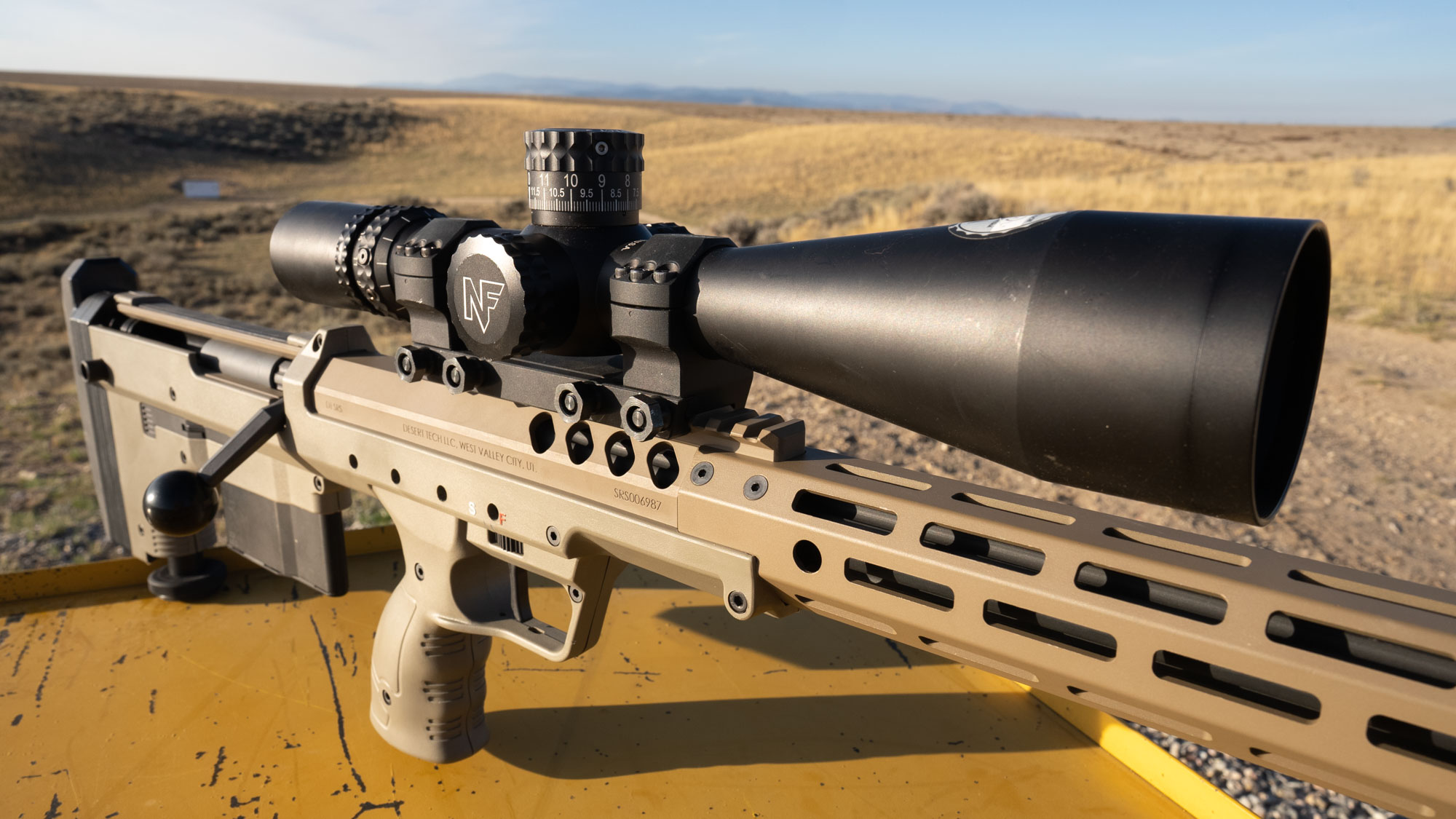
Switching Barrels
To change barrels on the Desert Tech SRS A2 you turn a selector on the left side of the rifle 180-degrees from “lock” to “unlock” using a 5mm hex head. Then you loosen four captured screws on the right side of the rifle with the same bit. With that done you can slide the barrel free from its recess in the receiver and replace it with a different one.
If you are switching to a cartridge with a different overall length, or one that uses a different sized bolt face, you’ll need to swap out the bolt, magazine, and bolt stop too.
This isn’t difficult either. After removing the recoil pad and LOP spacers from the stock—which is done by squeezing a small tab on the underside of the recoil pad assembly and sliding it free—the bolt stop and bolt come right out. You drop the new bolt into the receiver, put the new bolt stop in place, reattach the recoil pad, and you’re good to go.
Desert Tech says this can be accomplished in under a minute. I was never in that much of a hurry, but even at my more leisurely pace this only took a couple minutes from start to finish.
When snugging up the four fasteners that clamp the barrel into place you use the T-handled 80 in.-lb. torque wrench that Desert Tech sells. When properly torqued Desert Tech says the rifle’s zero won’t shift when you remove a barrel and reinstall it. During my testing, this was the case. There’s no doubt that the engineering behind the design is solid.
Switching Hardware
One caveat to the speedy barrel-swapping capabilities of the Desert Tech SRS A2 is when you need to change out the handguard to accommodate a shorter barrel, as was the case when I went from the 24-inch 6.5 Creedmoor to the 18-inch .308 Win.
The 12.5-inch handguard that pairs with the Creedmoor was too long for the .308 barrel, which needed the stubbier 7-inch handguard. The handguard attaches to the receiver with eight fasteners—four on the top and four on the bottom. There’s also one fastener that pins the two sides of the polymer lower that goes through the bottom of handguard—so nine fasteners in total.
The four fasteners up top and the crossbolt fastener are exposed and easy to get to. But the four fasteners on the bottom of the handguard that screw into the receiver are hidden under the polymer lower. Removing the clamshell lower to get at those fasteners is a chore and a half. Just make sure you have a clean work surface when you do this as you need to remove about a dozen fasteners to accomplish the job.
The handguards on the A2 version have M-Lok slots machined on all the flats so there are plenty of ways to mount extras on the rifle if you desire.
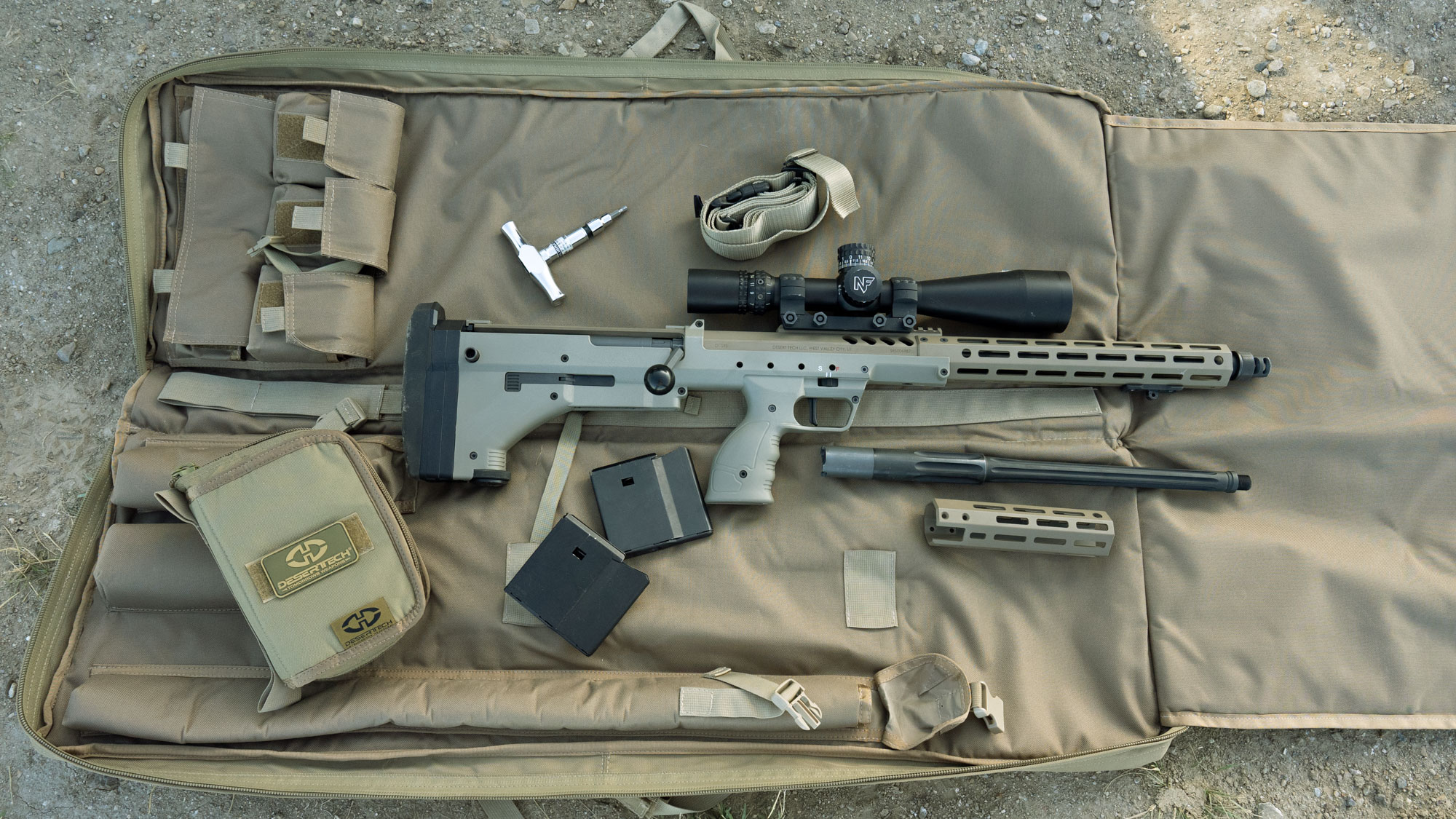
Desert Tech SRS Ecosystem
Given the modular design of the Desert Tech SRS, it isn’t surprising that when you go to order the rifle you have a bunch of choices to make. The base rifle consists of the stock style, the color pattern, and the caliber selection. From there you can add conversion kits to run different calibers and a whole host of goodies.
Basic Build
The base cost of the regular A2 chassis is $3,849 and the cost for the barrel and other pieces of the conversion kit is $1,700 to $2,050 depending on the cartridge you choose. With an extra conversion kit and the torque wrench the rifle comes to about $7,400. Extra magazines for the standard long- and short-action cartridges are $90.
Beyond these basics you have a bunch of accessories to pick from. Desert Tech takes pains to be a one-stop shop in this regard. They sell two types of bipod mounts that have a swivel stud for Harris-style bipods, one which is a QD mount ($80) and one that clamps on permanently and costs less ($21.75). Of course, you can order Harris bipod at the same time as you navigate through the rifle builder.
Scope Mounts
They also have three one-piece scope mounts. All are for 34mm scopes, which has become the most prevalent tube size for the kind of precision optic that shooters using a Desert Tech SRS are likely to employ. You can order the mount with three different tapers—20, 30, and 40 MOA—depending on how much declination you want in your scope. The cost for each is $365.
They are fairly minimal for this type of mount, using one fastener at the front and another at the rear to clamp on to the rail. The rear of the mount incorporates a bubble level so the shooter can correct for rifle cant without lifting their head off the stock.
Cases and Tool Kits
Desert Tech also sells some nice cases and tool kits for their rifles. You can get a soft case on its own or with a hard case that it slides into. These cases aren’t cheap, but they are among the best systems I’ve seen offered with a rifle. The soft case for the SRS is $295 and when paired with the locking hard case is $527.
The soft case folds open and accommodates an extra barrel and hand guard and has plenty of storage for tools and other gear. When fully deployed it lays flat and has a padded flap that folds forward, extending the length of the case so that it can be used as a shooting mat.
You can purchase tools for the rifle as well. One is a complete maintenance kit that includes a torque wrench, Allen key set, and various cleaning supplies like bore snakes, solvent, brushes, cleaning patches, lens brush, lens pen and so on. It costs $345. Or you can just purchase the 80 in.-lb. torque wrench, which you’ll need to swap barrels and hardware, for $145. Personally, I’d just purchase the wrench and use a portion of the extra $200 that the full maintenance kit costs to buy the other stuff.
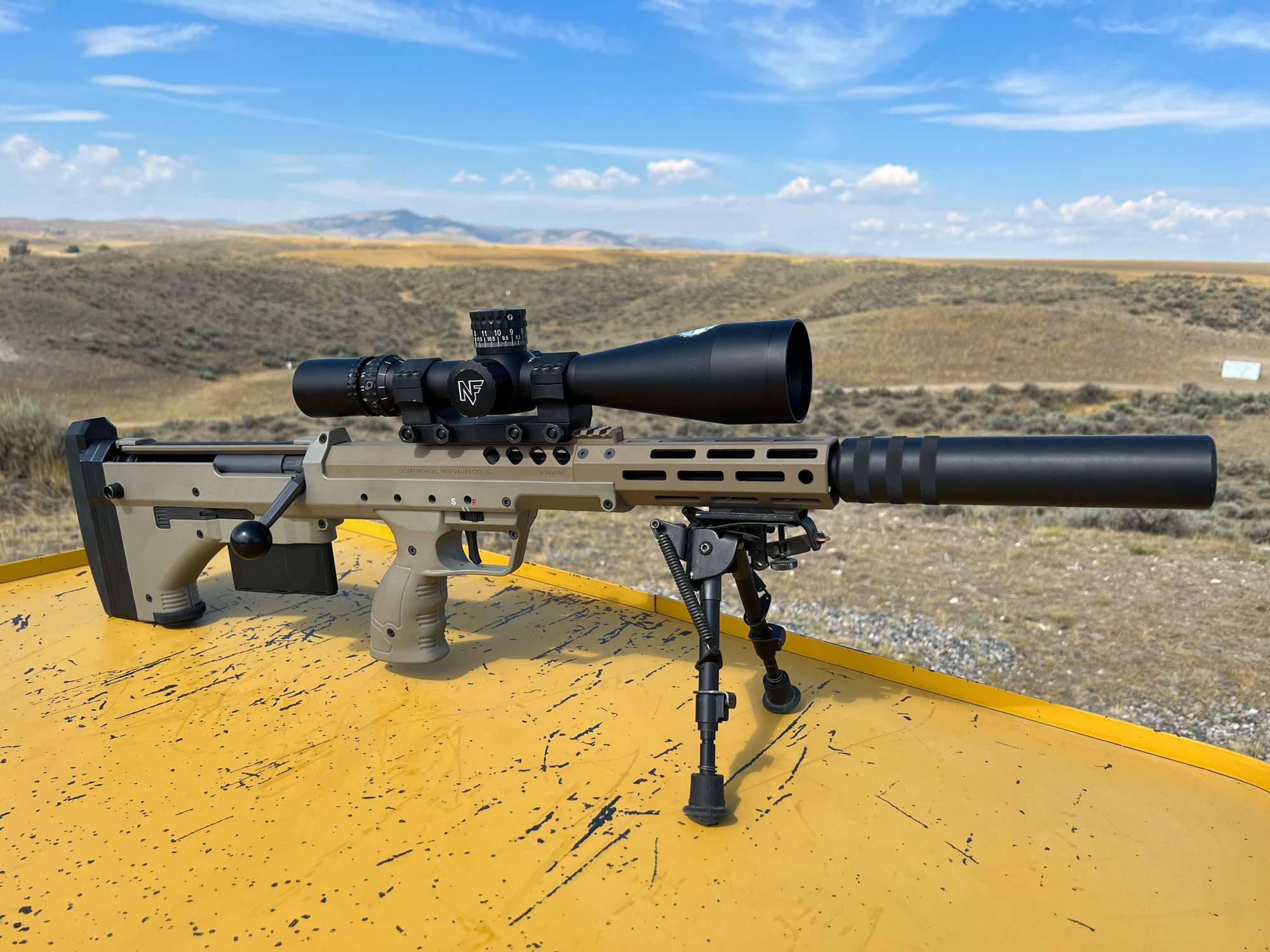
Pros and Cons of the Desert Tech SRS A2
Pros
- Very good accuracy
- Compact, ergonomic design
- Handy in tight quarters
- Switch barrel capability
Cons
- Expensive
- Fairly heavy
- Swapping handguards is cumbersome
Final Thoughts
One of the most appealing facets of the Desert Tech SRS A2 is the cool factor. It is a sweet looking rifle that is fun to shoot. Is it the best precision rifle out there? I don’t think it can make that claim, but it shoots well enough to hang with the big dogs in that world. Is it a good hunting rifle? In some niche cases, yes, it is very capable but for most hunting scenarios it probably isn’t the first gun you’ll pull from the rack.
Read Next: How To Get The Most Out Of Your Precision Rifle Scope
But in terms of being a blast to shoot, it doesn’t have many equals. Yes, it is an expensive system, but for anyone who’s thrown down money for a bass boat, a jacked diesel pickup, or a tricked out Harley, the Desert Tech SRS A2 scratches that same itch. There are plenty of worse ways to spend your kids’ inheritance.
We may earn revenue from the products available on this page and participate in affiliate programs. Learn More ›

